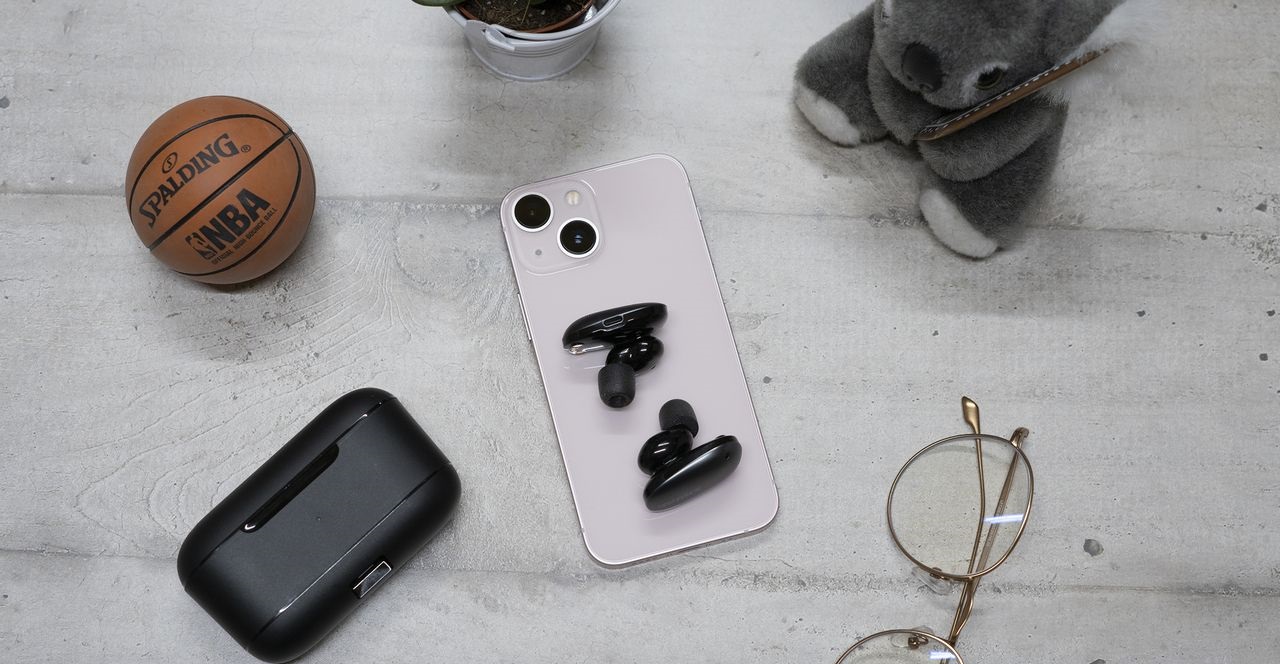Shure AONIC Free
With the Aonic Free, Shure is seriously tackling the true wireless headphone market. Beyond the promise of excellent sound performance, this model is all about amazing passive isolation and extensive customization.
Presentation
After timidly jumping on the true wireless bandwagon in 2020, turning some of its wired models into wireless versions by attaching small Bluetooth modules to the MMCX connectors, Shure is now jumping on the bandwagon with the Aonic Free. The Aonic Free is Shure's first true wireless headset to be exclusively wireless.
Unlike many of their competitors, the Aonic Free doesn't feature active noise reduction, but instead relies on a foam-tipped design that naturally blocks outside noise. Shure also promises a lot about the sound quality delivered by the headphones, as well as the pickup capabilities of their microphones, which we will obviously take the time to check out in this test.
Manufacturing & Accessories
For its first pair of exclusively true wireless earphones, Shure opted for a particularly imposing design that recalls Sony's WF-1000XM3 or some Bose earphones. Each earphone is indeed composed of an external part coming out in a pronounced way of the pavilion and of a small protuberance in the shape of bean coming to be lodged in the hollow of the ear. The case is also very imposing since it is not far from making the size of a soap brick! It is thus difficult to carry in a trouser pocket and to use with one hand.
Apart from the size of the whole, the Aonic Free and its casing remain quite elegant and sober. The quality of manufacture is irreproachable, the traces of assembly are very discrete and the whole seems robust. The hinge of the case will undoubtedly be able to survive multiple opening cycles without flinching. Shure also claims that its headphones are splash and perspiration resistant, although no mention is made of any IP certification. Of course, you'll need to make sure you properly care for the earphones after each sports session to minimize sweat damage.

Comfort & support
Despite their large size, the Aonic Free are very comfortable to wear. The weight of 6.7 g per earphone is well distributed thanks to the bean-shaped internal area, which is delicately placed in the hollow of the ear without applying any particular pressure point. The Aonic Free can therefore be worn for long hours without any real discomfort... as long as you can bear the feeling of intrusion induced by the in-ear design. The Aonic Free come with three pairs of eartips made of memory foam and not silicone, as is often the case with true wireless earphones. The foam is particularly pleasant here and hugs the walls of the ear canal perfectly.
With these Aonic Free, Shure took the gamble of not incorporating active noise reduction and relying on the design of its earphones, as well as on memory foam tips to block out outside sounds. We have to admit that the passive isolation provided by these tips is one of the best we've tested to date. We recommend reading the article below for more information on this technical achievement.
User experience
The Aonic Free is controlled by the mechanical button on top of each earphone. The two buttons are easy to reach, responsive and provide a full range of controls: track navigation, playback and call management, volume control, wizard and environment mode activation, nothing is missing.
The Aonic Free communicate via Bluetooth 5.0 and are compatible with SBC, AAC and aptX codecs. In addition, the headphones keep in memory the last connected devices, so it is not necessary to restart the pairing with a source already connected before, knowing that the handling is far from intuitive. In fact, you have to switch off one of the headphones with a 2 second press on the button and switch it on again with a 5 second press to start the pairing. We have already seen simpler.
The Aonic Free can also work in tandem with the ShurePlus Play app, which is simply one of the most complete and enjoyable apps we've come across so far. It gives you access to a precise equalizer, various customization options for controls or voice prompts (available in French), but also information such as the remaining battery level or the Bluetooth codec used. Shure also seems to have listened to the complaints of the Aonic 50 headset users since, unlike the Aonic 50, all settings are stored in the headset's memory, allowing you to switch from one source to another without losing your habits or personal equalization. The app also has a tab that aggregates all music stored locally on the smartphone.
Despite all these positive points, some very practical features are missing. This is the case of a presence sensor that would allow to automatically pause the music when the earphones are removed, and to restart it when they are placed back in the ears. In addition, the possibilities of control are a little more limited and no switch in mono is carried out when one uses an ear-phone in solo (left or right channel of the stereo signal truncated).
Autonomy
The Aonic Free never lived up to the 7-hour promise made by Shure. We measured an autonomy varying from 6 h to 6 h 30 min depending on the Bluetooth codec used (aptX being a little more energy consuming). Such an operating time places them in the average of what is currently found on the market of true wireless earphones, even if for a few months, the new models tend to approach 8 h, even to exceed them.
The small disappointment comes from the case which provides only about two additional charges, which is very little considering its imposing size.

Hands-free kit
In a quiet environment, the voice pickup of the Aonic Free microphones is correct. The voice is perfectly intelligible, but it clearly lacks naturalness, sounds distant and fluent, because it is totally altered by the limited bandwidth of the microphones, but also the very marked colorations of the sound signature. Moreover, the sibilant and whispering sounds ([s], [f] and [ʃ]) are particularly piercing and can even sound aggressive.
In noisy environments, the Aonic Free do honorably thanks to an effective noise reduction algorithm. Even near a crossroads or a busy road, the voice remains intelligible and is only covered on rare occasions: the passing of a bus or the acceleration of a motorcycle. However, the voice is still affected by the limited bandwidth and the unbalanced sound signature of the recording.
Latency
The communication latency in wireless mode of the Aonic Free is 320 ms. With such a delay, it is impossible to enjoy a video properly without experiencing a strong lag between the sound and the image. Nevertheless, the good management of the Bluetooth protocol of the headphones makes it possible to compensate for this latency on apps and video content sites like YouTube, Disney+ or Amazon Prime. Video games, however, are exempt from such treatment and therefore impractical.
Audio
For its first pair of exclusively true wireless headphones, Shure has taken care of the sound signature with a relatively balanced rendering, which can however be a little too sharp, too lively, the fault of a slightly too pronounced emphasis on the high-mids.
The faithful, almost linear behavior of the Aonic Free throughout the first part of the sound spectrum is reminiscent of Shure's IEM earphones. Without being surgically precise, the bass is both well defined, punchy and present without encroaching on the upper frequencies. Even on pieces very rich in bass, leading to a certain requirement of precision in this area, the headphones are never taken in default and we can always identify without difficulty each source officiating in this frequency zone.
This very good homogeneity continues until the border between midrange and high-midrange. Beyond about 2 kHz and up to 5 kHz, the Aonic Free are more generous and thus clearly emphasize the sharp, "snapping" and lively aspect of many elements. Fortunately, the accuracy of the timbres does not suffer excessively (although the attack or the rubbing on the strings, or the timbre of the snare drum, for example, are clearly more perceptible than expected), but the treatment that is proposed here is clearly not the softest. Remember that human hearing is the most sensitive in this area. Fortunately, nothing is set in stone, since it is possible to restore balance by compensating for this overweight with the equalizer in the ShurePlus Play app.
Another similarity with the sound signatures of some Shure in-ear monitors is the withdrawal of the highs present on the Aonic Free. Without any correction applied, and masked by the emphasis on the upper mids, the highs struggle somewhat to express themselves, and can lack "air" and definition: cymbals and certain room effects can sometimes seem muffled, "softer". As for the high-mids, it is possible to attenuate this behavior and to give a little vivacity to the highs by playing with the equalizer. Nevertheless, the level of detail of the highs is always perfectible even after this intervention.
Conclusion
Apart from a particularly imposing design, Shure has produced its first pair of true wireless-only headphones, which are particularly convincing. Accompanied by an excellent companion app, the Aonic Free provide good sound performance, but above all shine with their passive isolation, which is unheard of on a product of this kind. Good at everything, the Aonic Free do not excel in anything, and this is what prevents them from becoming a true wireless headphone.




